- Home
- Terry Pratchett
The Folklore of Discworld Page 11
The Folklore of Discworld Read online
Page 11
Sergeant Angua of the Ankh-Morpork City Watch is different again. Like Ludmilla, she is compelled to become a wolf during the time of the full moon, but in addition she has the power to shape-shift at will, by day or night, at any time of the month. This gift is a great advantage to her in police work; when in wolf form she has a superb sense of smell, thanks to which she can track anyone anywhere and decipher subtle clues at crime scenes. And, as many a villain has found out, it is most disconcerting to chase an attractive and unprotected girl into a dark alley, only to find a pile of discarded clothes and a large she-wolf, teeth bared. However, she has certain weaknesses. For a day or two before her Change she becomes irritable, due to Pre-Lunar Tension. When she is in wolf form the touch of any silver object gives her intense pain, and (like werewolves on the Earth) she is vulnerable to silver bullets. Some strong smells overwhelm her delicate nose, bringing on the equivalent of acute hay fever.
Angua’s parents are the extremely aristocratic Baron Guye von Uberwald (also known as Silvertail) and Baroness Serafine von Uberwald (also known as Yellowfang). The Baron spends most of his time in wolf form, to the annoyance of his wife. Angua had a brother named Wolfgang, a magnificently built and very athletic young man, with strongly Nietzschean views, who made a terrifying wolf and would have felt quite at home in the SS. Even his father was afraid of him. But, as she tells Carrot, she also has another brother, Andrei, and she did have a sister named Elsa, till Wolfgang killed her.
‘He said it was an accident. Poor little Elsa. She was a yennork, just like Andrei. That’s a werewolf that doesn’t change, you know? I’m sure I’ve mentioned it. Our family throws them up from time to time. Wolfgang and I were the only classic bimorphs in the litter. Elsa looked human all the time, even at full moon. Andrei was always a wolf.’
‘You mean you had a human sister and a wolf brother?’
‘No, Carrot. They were both werewolves. But the, well, the little … switch … inside them didn’t work. They stayed the same shape. In the old days the clan would kill off a yennork quickly, and Wolfgang is a traditionalist when it comes to nastiness. He says they made the blood impure. You see, a yennork would go off and be a human or a wolf but they’d still be carrying the werewolf blood, and then they’d marry and have children … or pups … and, well, that’s where the fairytale monsters come from. People with a bit of wolf, and wolves with that extra capacity for violence that is so very human. But Elsa was harmless. After that, Andrei didn’t wait for it to happen to him. He’s a sheepdog over in Borogravia now. Doing well, I hear. Wins championships.’ [The Fifth Elephant]
Not surprisingly, Angua has broken with her family.
But the existence of the yennork explains a lot. No doubt the aristocratic werewolves guard their pedigrees carefully, but mistakes will happen, even in the best regulated families.
IGORS
The Igors are a very numerous humanoid family in the Uberwald region, each of whom is named either Igor or Igorina. They are not, of course, undead, but are usually standing very close to a corpse. They are, in fact, a big nod to the cinematic cliché that whenever there is a brain to be collected or a big crackling switch to be pulled, then there is an Igor, or someone who looks very much like him, ready and willing to do the job.
Igors are heavily built, with a strong tendency to lurch and shamble, and they speak with a heavy, spluttering lisp. For generations many of them have gone into service in the households of aristocratic vampires in Uberwald, where it is their pride and joy to ensure that massive doors creak, candles gutter, cobwebs abound, and carriages look as much like hearses as possible. They have a keen appreciation of all the traditional trappings of horror. Sadly, Earthly vampires, unlike those of the Disc, seem never to have employed Igors. As we have pointed out, they did not have many visitors.
Another reason why Igors like working for vampires is that their castles usually have large, deep, cool cellars where an Igor can quietly pursue his real interests. The whole clan has a remarkable hereditary skill in surgery, especially transplants and wound repair, including the replacing of severed limbs. This they practise both on themselves and on others. You can always recognize an Igor by his distinctly patchwork look and interestingly individual scar patterns, and maybe an extra thumb or mismatched eyes. In many cases, you could place a ball on the top of his head, and it would not roll off.
The Igorinas, on the other hand, use their skill to look absolutely stunning, but always include some fetching little detail – a beautifully curved scar under one eye, a line of decorative stitching round the wrist – to maintain the Family Look.
Since Igors hate discarding any body part that could be recycled, an elderly member of the clan will make arrangements for the best bits of himself to be shared out among his kin when the time comes. They have a great fondness for heirlooms; among Igors, ‘he’s got his grandfather’s hands’ is likely to be literally true.
There is a tradition among Igors that the ancestor who first learned surgery was working for a mad doctor at the time. A more recent member of the clan, who diversified into extremely delicate clock-making, produced references from a series of employers whose hold on sanity appears to have been shaky – Mad Doctor Scoop, Crazed Baron Haha (crushed by a burning windmill), Thcreaming Doctor Bertherk (died of blood poisoning caused by a dirty pitchfork), and Demented Doctor Wimble, who discovered how to make the perfect clock while working on a scheme to extract sunshine from oranges. This particular Igor has a passion for electricity and thunderstorms, as described in Thief of Time.
There are few echoes of the Igors on Earth. And those that there are are only to be found in modern cinema and comic strips, not in age-old folklore. However, they do support the idea that an Igor once worked for a Doctor Frankenstein (who was definitely crazy) on a job which involved a great deal of stitching body parts together and exposing them to lightning. The Doctor wouldn’t have got far without his help.
Despite the people they work for, Igors are generally well-intentioned, nay, spiritual beings. Most religions teach that the body is just an outer garment, to be shed in due time, and Igors think, in a provident way, that items with some wear left in them should not be wasted.
ZOMBIES
It is not strictly accurate to include the Discworld zombies in this chapter, since (unlike werewolves, golems or Igors) they do not constitute a separate race or species. On the contrary, a zombie is simply a human being who obstinately remains sort-of-alive when he has in fact died. He ought to lie a-mouldering in his grave, instead of wandering around looking vaguely grey, with fingers dropping off occasionally. No one knows why some people are natural zombies; it may simply be stubborn bloody-mindedness, an inborn refusal to kowtow to any authority, even that of Death. What Death thinks of this situation has not been recorded.
On the Disc, it would seem that zombies keep the personalities they had when alive, more or less intact, with the result that the four we know best are strikingly different. One is Mr Slant, the eminent lawyer who can count most of the upper-class families in Ankh-Morpork among his clients. He is dry-as-dust, in a very literal sense, and though he would never (of course) do anything illegal, it is not wise to cross him. He knows family secrets going back for an uncomfortable number of generations. At the opposite end of the city’s social and political spectrum is Reg Shoe. In life he saw himself as a romantic revolutionary; in death he devotes most of his energies to protesting at society’s unjust prejudice and discrimination towards the Undead. Then there is the old wizard Windle Poons, who finds his time as a zombie considerably more exciting than his actual life had been, as we learn in Reaper Man; in his case, however, it is merely a temporary state – the default setting for someone who happens to die when Death is not around to do whatever it is he does with his scythe. And in distant Genua there is Baron Saturday, a zombie who may be something more than just that. His name and his appearance suggest that he has an Earthly counterpart in the sinister Baron Samedi in Haiti – a being w
ho is not himself a zombie or ghost, but a spirit Lord of the Dead. He is seen at crossroads and in cemeteries, and can be recognized by his black tuxedo, white top hat, dark glasses, and skull-like face. He is greatly feared.
Earth’s zombies, who are only to be found in the traditional beliefs of Haiti, are very, very different, despite the identical name, and despite the fact that they too are Undead humans. Their condition is due to the spells of some voodoo sorcerer who has called them from their graves – and who, some say, was responsible for putting them down there in the first place, having sent them into a death-like trance by a secret poison, concocted from the liver of a very rare fish (it appears, from a conversation recorded in Reaper Man, that the wizards of Unseen University have heard rumours about this). When Haitian zombies emerge, their minds and souls have gone; they have become mere robots, incapable of speech, who must serve the sorcerer as his slaves. However, there is one way to rescue a zombie: give him salted food, or salt water to drink, and his soul and his power of speech will be restored.
It is said there was once a girl who died and was buried, but she was seen three years later, working very long hours in a boutique; she looked much the same as in the past, except that her neck was twisted – and that was because her coffin had been too small, and they had had to force her head down. But she spoke to nobody, and her eyes had no life in them.
Reg Shoe, the tireless revolutionary and champion of the Rights of the Undead, would be unspeakably angry if he knew the plight of the poor, exploited, downtrodden zombies of Haiti.
6 And also that in the inevitable chase scene the coach would always break down in the same place in Black Park, near Pinewood Studios – according to Terry. This may not be strictly true, but it gave him the idea for Don’tgonearthe Castle.
7 As we will see later, two hearts are magical. However, the only known person with two hearts on the planet Earth is Doctor Who.
8 See the section above on vampires, where this same thing is mentioned as one possible cause for the condition. For much of the early history of these creatures (that is, before the days when vampires dressed snappily and werewolves generally managed to keep their trousers on) they were in most cultures pretty much the same thing. Someone who was a werewolf when alive would keep up the bad work by becoming a vampire when dead.
Chapter 7
BEASTIES
IT IS ONE OF THE MYSTERIES of the multiverse that animals which exist as normal flesh-and-blood creatures in one world are regarded as imaginary, legendary or folkloric in another – and yet, in many cases, the descriptions tally almost perfectly. Whether this is due to the perpetual drifting of particles of knowledge through cosmic space, or whether such species did once inhabit all worlds and have regrettably become extinct in some of them, is a matter of debate.
But nobody can deny that the fauna of the Discworld is particularly rich in species which other worlds have dreamed of. Not for nothing does the old song run:
All beasts bright and beautiful,
All monsters big and small,
All things weird and wonderful,
The Discworld has them all.
DRAGONS
On our world, the image of the dragon is so widespread and so deep-rooted that it can truly be said that its origins are lost in those famous mists of time. It’s a persistent image, too. Even after the last land masses had been explored, and map-makers were forced to admit that ‘Here be no dragons’, people still reported seeing sea-serpents, and huge scaly things in lakes. And to this day there are innumerable storytellers and artists, still eagerly creating and re-creating dragons in their works. There must be a powerful flow of draconicons still pouring into the Earth from some other universe. It seems likely that the source is the Discworld, which can boast of two flourishing species and has some awareness of a third.
(a) Draco vulgaris
Visitors to Ankh-Morpork and other Discworld cities have often commented on the charming fashion for society ladies to wear small, colourful dragons on their shoulders; in the winter months, they are also popular as muffs and foot-warmers. These are miniature specimens of Draco vulgaris, the Common Swamp Dragon, which probably no longer exists in the wild but has been bred in captivity for many generations. The basic type is the Common Smut, familiar to all, from which numerous distinct varieties have been developed; some three dozen are recognized for show purposes (details obtainable from the Cavern Club Exhibitions Committee). Most are of amiable disposition, but it should be noted that the Golden Deceiver retains some characteristics of its wild ancestors; it makes a good watch dragon but should not be allowed near children.
To own a pedigree Swamp Dragon is a mark of taste and refinement, but also requires a degree of patience which, alas, all too few would-be owners possess. Where dragons are kept, damage to furniture and clothing is inevitable, and chemical effluvia are frequently emitted which some persons of delicate constitution may find offensive. Most dragons are highly strung, excitable little creatures, so great care must be taken in approaching and handling them, if the owner wishes to avoid scratches, bites, and unsightly loss of hair through sudden flaming at close range. The owner can also expect much expense on vets’ bills, since dragons suffer from a multitude of ills – Slab Throat, Skiplets, The Black Tups, Storge and Staggers, to name but a few (see Diseases of the Dragon, by Sybil Deirdre Olgivanna Ramkin). Their digestive systems are liable to catastrophic malfunctions, notably Blowback, which is invariably fatal. Needless to say, all varieties readily explode under stress.
There has been much debate as to how so delicate and vulnerable a species can have evolved and survived. True, their native habitat in the swamps of Genua was fairly inaccessible, and they had no natural predators; the only external danger was from callous young men who had worked out that the simplest way to set yourself up as a hero was (in the words of Sir Samuel Vimes) ‘to come plodding into the swamp to stick a sword into a bag of guts that was only one step away from self-destruction anyway’. Yet their entire metabolism seems radically unsuited to Discworld conditions. Leonard of Quirm has proposed the bold theory that swamp dragons did not originate on the Disc but are descended from the non-discly species Draco nobilis (see below), showing adaptations for a heavy-air environment. The difference in size would thus be an example of evolutionary dwarfism, a process well attested in isolated populations.
(b) Draco nobilis
Everyone on the Discworld and on Earth has heard of the Noble or Great Dragon – a creature many times larger than the Swamp Dragon, fierce, untameable, with scales and claws and breath like a blast furnace, coiled up in its secret lair on top of a great hoard of gold. In traditional tales, such dragons fed on virgins and could only be slain by heroes (preferably the long-lost heirs of kingdoms), and we shall have more to say on this in a later chapter. But were they myth, or were they real?
At the time of the events recounted in Guards! Guards! the most that could be said was that they were a great mystery. Lady Sybil Ramkin knew that they used to turn up from time to time, full of vim and vigour, but had ceased coming. She believed they had migrated to somewhere where gravity wasn’t so strong, where they could fulfil their potential and be all that a dragon should be. Lord Vetinari was positive that they were extinct, despite the fact that something large, hot and angry was incinerating portions of the city. The Unique and Supreme Lodge of the Elucidated Brethren of the Ebon Night were using rituals to summon and control a Great Dragon. They discovered that if summoning is hard, control is much, much harder. But at least nobody could still argue that Draco nobilis was a myth. Ensuing events confirmed that Draco vulgaris and Draco nobilis are indeed related, but gave no clue as to the latter’s current habitat.
The wizard Rincewind claimed to have learned, in the course of a very alarming early experience of his own, that most of the time they do not exist as people generally understand ‘existence’, but only potentially:
The true dragon is a creature of such refinement of spirit that th
ey can only take on form in this world if they are conceived by the most skilled imagination. And even then the said imagination must be in some place heavily impregnated with magic, which helps to weaken the walls between the world of the seen and unseen. Then the dragons pop through, as it were, and impress their form upon this world’s possibility matrix. [The Colour of Magic]
Some years later, Rincewind revised his views on the mystery in the light of fresh discoveries. When the intrepid voyagers on Leonard of Quirm’s flying machine landed briefly on the Disc’s moon (as recounted in The Last Hero), they found a population of magnificent silver dragons of all sizes, feeding on moon-plants with metallic silver leaves. They were completely unafraid of humans; indeed, the little ones would swarm all over people, like kittens. It is plausible to assume that these superb creatures are a variety of Draco nobilis. How we yearn to know more about them! But it seems the gods have decreed that no more flying machines shall be built. Probably this is for the best. Let the Moon Dragons enjoy their serene life, safe from the deplorable impact of humanity. The true dragon-lover must rejoice for them.
(c) Draco maritimus immensis
No other dragon species has actually been observed on or near the Disc, but according to Scandinavian mythology there was (or is) a third one on Earth, the aquatic Midgardsorm or Middle-Earth Worm (Draco maritimus immensis). It is written that it lies on the seabed, encircling the whole Earth, where it will remain till the end of the world, when it will emerge, and a particularly stupid Norse god named Thor will clobber it with a hammer. It is some comfort that it is also written that its dying breath will poison him.

 Feet of Clay
Feet of Clay The Color of Magic
The Color of Magic Thud!
Thud! Good Omens: The Nice and Accurate Prophecies of Agnes Nutter, Witch
Good Omens: The Nice and Accurate Prophecies of Agnes Nutter, Witch I Shall Wear Midnight
I Shall Wear Midnight Mort
Mort Raising Steam
Raising Steam Guards! Guards!
Guards! Guards!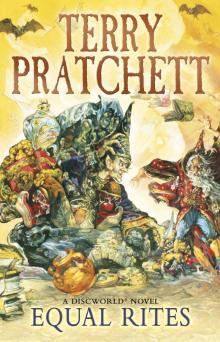 Equal Rites
Equal Rites A Hat Full of Sky
A Hat Full of Sky The Light Fantastic
The Light Fantastic Mrs Bradshaw's Handbook
Mrs Bradshaw's Handbook Wyrd Sisters
Wyrd Sisters Soul Music
Soul Music Small Gods
Small Gods Sourcery
Sourcery Reaper Man
Reaper Man Night Watch
Night Watch Lords and Ladies
Lords and Ladies The Fifth Elephant
The Fifth Elephant Monstrous Regiment
Monstrous Regiment The Truth
The Truth Witches Abroad
Witches Abroad Eric
Eric Going Postal
Going Postal Men at Arms
Men at Arms Jingo
Jingo The Amazing Maurice and His Educated Rodents
The Amazing Maurice and His Educated Rodents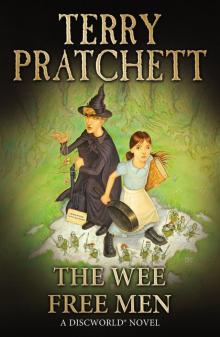 The Wee Free Men
The Wee Free Men Pyramids
Pyramids Wintersmith
Wintersmith Moving Pictures
Moving Pictures Carpe Jugulum
Carpe Jugulum Interesting Times
Interesting Times Maskerade
Maskerade Making Money
Making Money The Shepherd's Crown
The Shepherd's Crown Hogfather
Hogfather Troll Bridge
Troll Bridge The Last Continent
The Last Continent The Sea and Little Fishes
The Sea and Little Fishes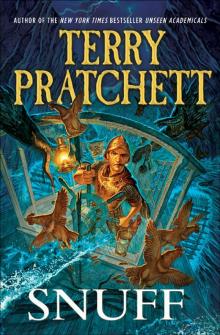 Snuff
Snuff Unseen Academicals
Unseen Academicals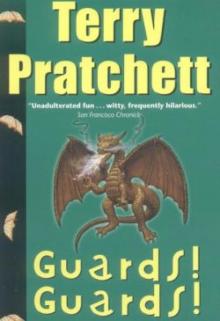 Guards! Guards! tds-8
Guards! Guards! tds-8 Jingo d-21
Jingo d-21 Turtle Recall: The Discworld Companion ... So Far
Turtle Recall: The Discworld Companion ... So Far The Fifth Elephant d-24
The Fifth Elephant d-24 Discworld 39 - Snuff
Discworld 39 - Snuff The Long War
The Long War Only You Can Save Mankind
Only You Can Save Mankind The Science of Discworld III - Darwin's Watch tsod-3
The Science of Discworld III - Darwin's Watch tsod-3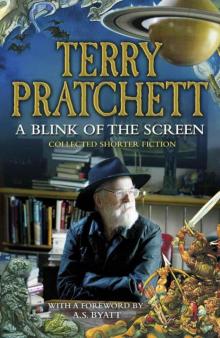 A Blink of the Screen: Collected Short Fiction
A Blink of the Screen: Collected Short Fiction Unseen Academicals d-37
Unseen Academicals d-37 Wings
Wings Making Money d-36
Making Money d-36 A Blink of the Screen
A Blink of the Screen Johnny and the Bomb
Johnny and the Bomb Dodger
Dodger Strata
Strata Discworld 02 - The Light Fantastic
Discworld 02 - The Light Fantastic The Folklore of Discworld
The Folklore of Discworld The Science of Discworld
The Science of Discworld The Unadulterated Cat
The Unadulterated Cat Raising Steam: (Discworld novel 40) (Discworld Novels)
Raising Steam: (Discworld novel 40) (Discworld Novels) The World of Poo
The World of Poo Discworld 05 - Sourcery
Discworld 05 - Sourcery The Witch's Vacuum Cleaner: And Other Stories
The Witch's Vacuum Cleaner: And Other Stories The Science of Discworld II - The Globe tsod-2
The Science of Discworld II - The Globe tsod-2 Small Gods: Discworld Novel, A
Small Gods: Discworld Novel, A Men at Arms tds-15
Men at Arms tds-15 Tama Princes of Mercury
Tama Princes of Mercury The Last Hero (the discworld series)
The Last Hero (the discworld series) The Long Utopia
The Long Utopia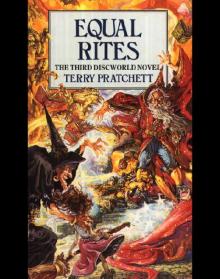 Discworld 03 - Equal Rites
Discworld 03 - Equal Rites Terry Pratchett - The Science of Discworld
Terry Pratchett - The Science of Discworld The Long Earth
The Long Earth The Carpet People
The Carpet People The Sea and Little Fishes (discworld)
The Sea and Little Fishes (discworld)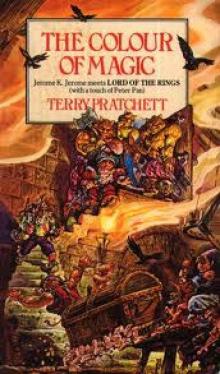 The Colour of Magic
The Colour of Magic Discworld 16 - Soul Music
Discworld 16 - Soul Music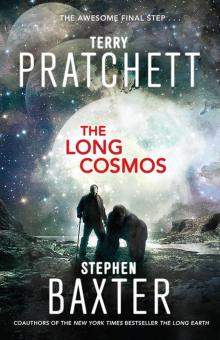 The Long Cosmos
The Long Cosmos The Dark Side of the Sun
The Dark Side of the Sun Monstrous Regiment tds-28
Monstrous Regiment tds-28 The Bromeliad 3 - Wings
The Bromeliad 3 - Wings Dragons at Crumbling Castle: And Other Stories
Dragons at Crumbling Castle: And Other Stories Night Watch tds-27
Night Watch tds-27 The Science of Discworld I tsod-1
The Science of Discworld I tsod-1 The Bromeliad 1 - Truckers
The Bromeliad 1 - Truckers The Science of Discworld Revised Edition
The Science of Discworld Revised Edition The Abominable Snowman
The Abominable Snowman Father Christmas’s Fake Beard
Father Christmas’s Fake Beard The Bromeliad Trilogy
The Bromeliad Trilogy A Slip of the Keyboard
A Slip of the Keyboard The Wee Free Men d(-2
The Wee Free Men d(-2 Johnny and the Dead
Johnny and the Dead Mrs Bradshaw's Handbook (Discworld Novels)
Mrs Bradshaw's Handbook (Discworld Novels) Truckers
Truckers The Amazing Maurice and His Educated Rodents d(-1
The Amazing Maurice and His Educated Rodents d(-1 Diggers
Diggers Thief of Time tds-26
Thief of Time tds-26 Science of Discworld III
Science of Discworld III Dragons at Crumbling Castle
Dragons at Crumbling Castle Nation
Nation Darwin's Watch
Darwin's Watch Interesting Times d-17
Interesting Times d-17 The Bromeliad 2 - Diggers
The Bromeliad 2 - Diggers The Science of Discworld II
The Science of Discworld II